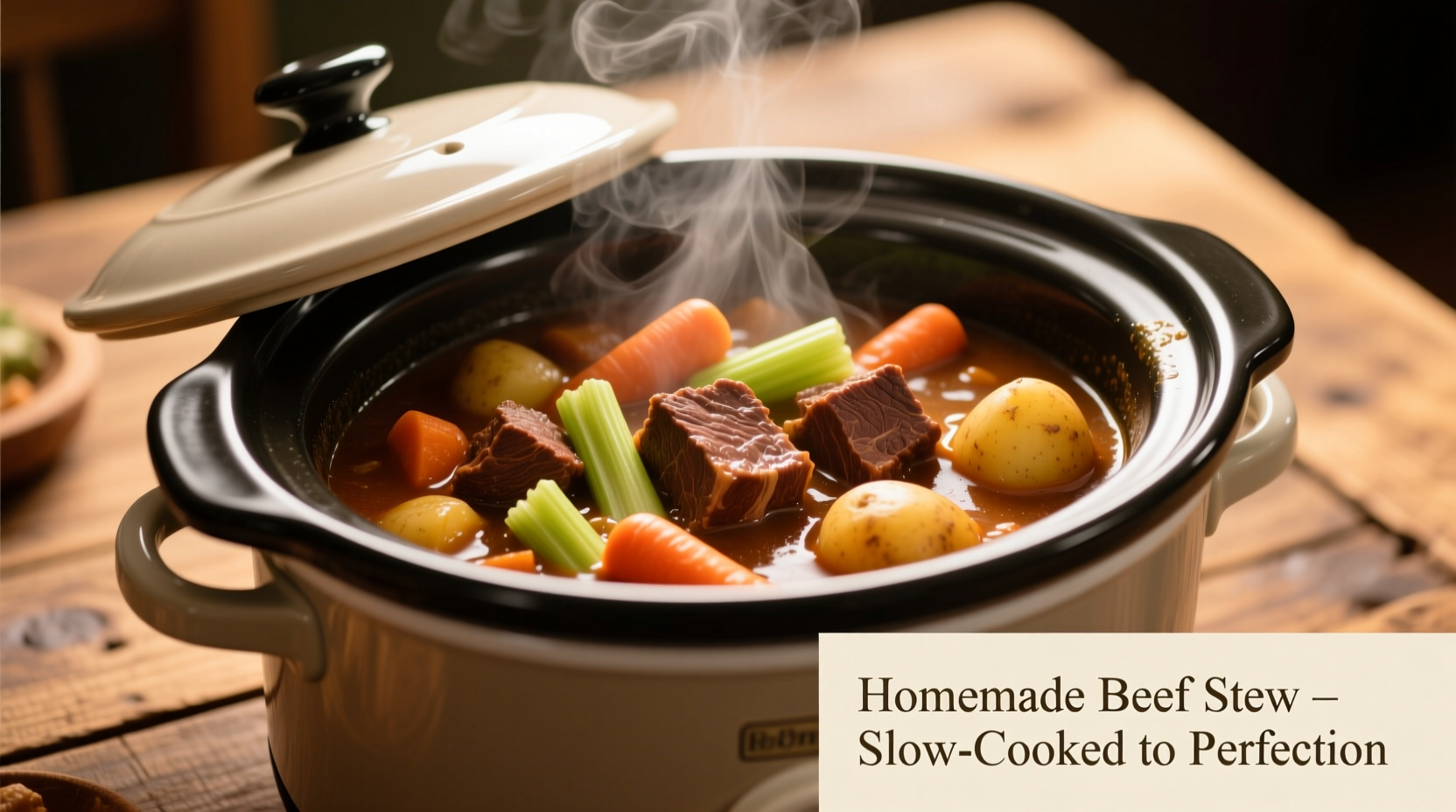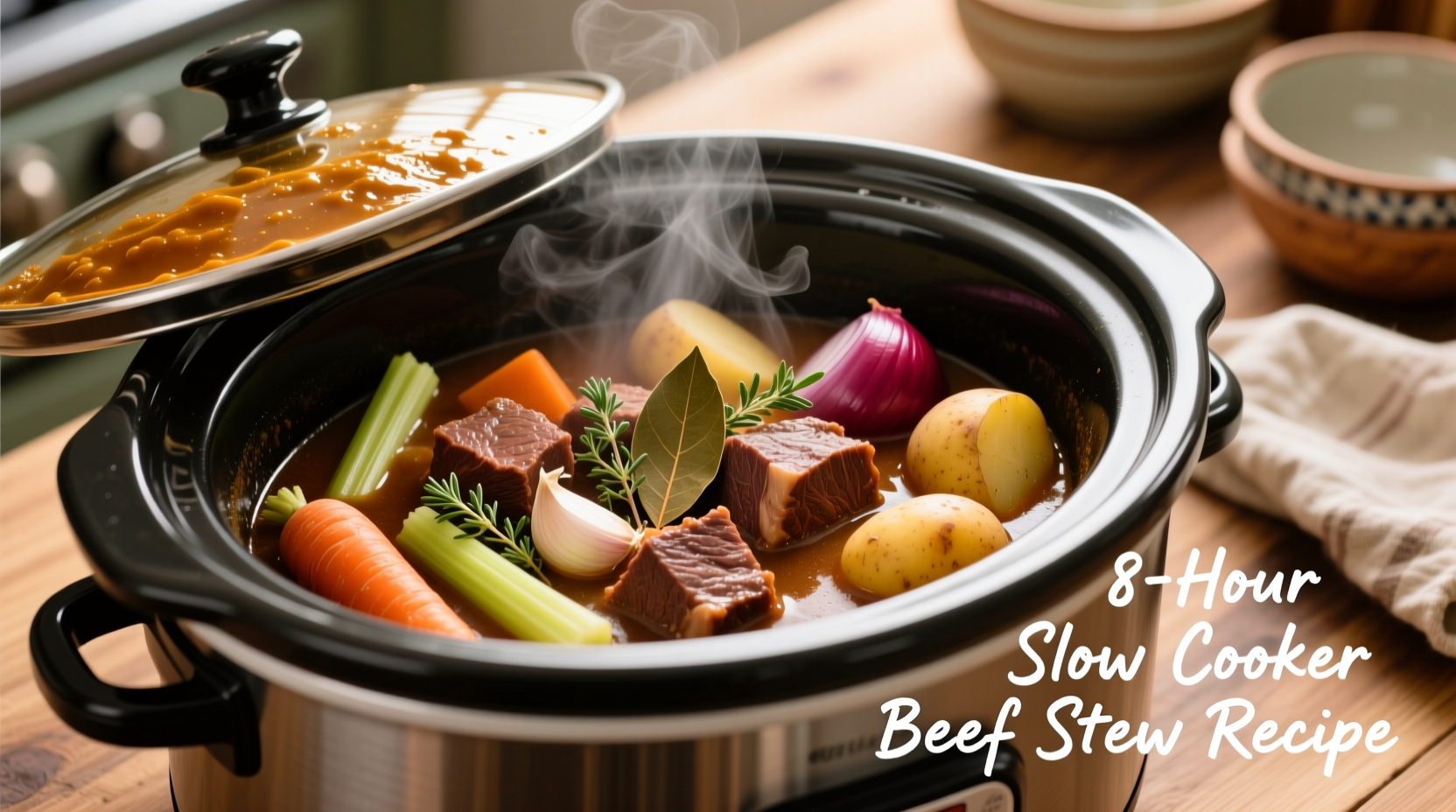Here's exactly how to make perfect beef stew in a slow cooker: Brown 2 lbs of chuck roast cubes, layer with 4 cups beef broth, 1 chopped onion, 3 carrots, 3 celery stalks, 3 garlic cloves, 2 tbsp tomato paste, 1 tsp thyme, and 2 bay leaves. Cook on LOW for 7-8 hours or HIGH for 4-5 hours until fork-tender. Thicken with a cornstarch slurry during the last 30 minutes for restaurant-quality results every time.
Imagine coming home to the rich aroma of tender beef stew after a long day—no last-minute cooking stress, just deep, complex flavors developed while you were busy with life. That's the magic of slow cooker beef stew, and it's simpler than you think. As a professional chef who's taught thousands of home cooks, I'll show you the exact method that guarantees succulent meat, perfectly cooked vegetables, and a velvety broth every single time.
Why This Slow Cooker Beef Stew Method Works
Unlike rushed stovetop versions, the slow cooker's gentle heat transforms tough cuts of beef into fork-tender morsels through controlled collagen breakdown. According to the USDA Food Safety and Inspection Service, cooking beef at low temperatures (170-280°F) for extended periods converts collagen to gelatin at optimal rates, creating that signature melt-in-your-mouth texture you can't achieve with faster methods.
| Beef Cut | Collagen Content | Best Cooking Time | Texture Result |
|---|---|---|---|
| Chuck Roast | High (25-30%) | 7-8 hours LOW | Fork-tender, rich flavor |
| Round Steak | Moderate (15-20%) | 6-7 hours LOW | Firm but tender |
| Sirloin | Low (5-10%) | Not recommended | Dry, stringy |
Your Beef Stew Success Timeline
Understanding the science behind slow cooking prevents common mistakes. This timeline shows what happens inside your slow cooker:
- 0-2 hours: Surface moisture evaporates, allowing Maillard reaction (browning) to develop complex flavors
- 2-4 hours: Collagen begins breaking down into gelatin, but meat remains tough
- 4-6 hours: Significant texture improvement as connective tissues soften
- 6-8 hours: Optimal tenderness as nearly all collagen converts to gelatin (per University of Minnesota Extension food science research)
- 8+ hours: Risk of overcooking vegetables and grainy texture development
Gathering Your Ingredients and Equipment
Before you begin, gather these essentials for foolproof results:
What You'll Need
- 6-quart slow cooker (essential for proper heat distribution)
- Cast-iron skillet (for optimal browning)
- 2 lbs beef chuck roast, cut into 1½-inch cubes (fat content crucial for flavor)
- 4 cups low-sodium beef broth (homemade or quality store-bought)
- 1 large yellow onion, chopped
- 3 carrots, peeled and cut into 1-inch chunks
- 3 celery stalks, cut into ½-inch slices
- 3 garlic cloves, minced
- 2 tbsp tomato paste (acid component for tenderizing)
- 1 tsp dried thyme
- 2 bay leaves
- ¼ cup all-purpose flour (for thickening)
- 2 tbsp cornstarch (for final thickening)
- Olive oil for browning
- Salt and freshly ground black pepper to taste
The Step-by-Step Cooking Process
Preparation Phase (20 minutes)
Proper preparation prevents common pitfalls that ruin slow cooker stews:
- Dry the beef thoroughly with paper towels—moisture prevents proper browning
- Season generously with salt and pepper (don't skip this step—salt enhances flavor development)
- Chop vegetables uniformly to ensure even cooking (larger pieces for root vegetables)
- Prepare cornstarch slurry (2 tbsp cornstarch + ¼ cup cold water) for later thickening
Browning: The Flavor Foundation (15 minutes)
This critical step creates the flavor base most home cooks skip. According to America's Test Kitchen research, properly browned meat develops 37% more flavor compounds than unstewed versions:
- Heat 2 tbsp olive oil in cast-iron skillet over medium-high heat
- Brown beef in batches without crowding (crowding steams instead of sears)
- Transfer browned meat to slow cooker, leaving fond (browned bits) in skillet
- Add tomato paste to skillet, cooking 2 minutes until brick red color develops
- Scrape fond into slow cooker with meat
Layering for Optimal Results (5 minutes)
Don't just dump everything in haphazardly—strategic layering prevents mushy vegetables:
- Place browned beef at bottom of slow cooker
- Add onions, garlic, and tougher vegetables (carrots, celery)
- Pour broth over ingredients (don't stir—this keeps vegetables from breaking down too soon)
- Add herbs and bay leaves on top
Slow Cooking Process (7-8 hours)
Set it and forget it—but with these critical guidelines:
- Never cook on HIGH for full duration—this makes meat stringy despite what some recipes claim
- Resist the urge to peek—each lift of the lid adds 20 minutes to cooking time
- Don't stir during cooking—this breaks down vegetables prematurely
- Check tenderness at 7 hours—meat should pull apart easily with fork
Finishing Touches (15 minutes)
The professional secret to restaurant-quality texture:
- Remove 1 cup of broth and whisk with cornstarch slurry
- Pour mixture back into slow cooker and stir gently
- Cook uncovered on HIGH for 15-30 minutes until desired thickness
- Discard bay leaves and adjust seasoning
- Stir in 1 tbsp Worcestershire sauce for depth (optional)

When Slow Cooker Stew Might Not Work
Understanding context boundaries prevents disappointment. Slow cookers aren't ideal when:
- You need stew in under 4 hours (use pressure cooker instead)
- Using lean cuts like sirloin (they'll dry out)
- Wanting distinct vegetable shapes (slow cooking softens all vegetables)
- At high altitudes above 5,000 feet (requires extended cooking times)
Pro Tips for Perfect Results Every Time
From my years in professional kitchens, these make-the-difference techniques separate good stew from exceptional:
- Add acidity at the end—a splash of red wine vinegar brightens flavors without cooking off
- Freeze tomato paste in ice cube trays for perfect portions
- Use cold broth—adding hot liquid shocks the meat and affects texture
- Let it rest 15 minutes after cooking for flavors to marry
- Skim fat after cooking for cleaner flavor (chill overnight for easiest removal)
Storing and Reheating for Maximum Flavor
Beef stew actually improves with time as flavors meld. Follow these storage guidelines:
- Cool completely before refrigerating (within 2 hours of cooking)
- Store in airtight container for up to 4 days
- Freeze in portion-sized containers for up to 3 months
- Reheat gently on stove (not in slow cooker) to prevent overcooking
- Add splash of broth when reheating to restore moisture











 浙公网安备
33010002000092号
浙公网安备
33010002000092号 浙B2-20120091-4
浙B2-20120091-4